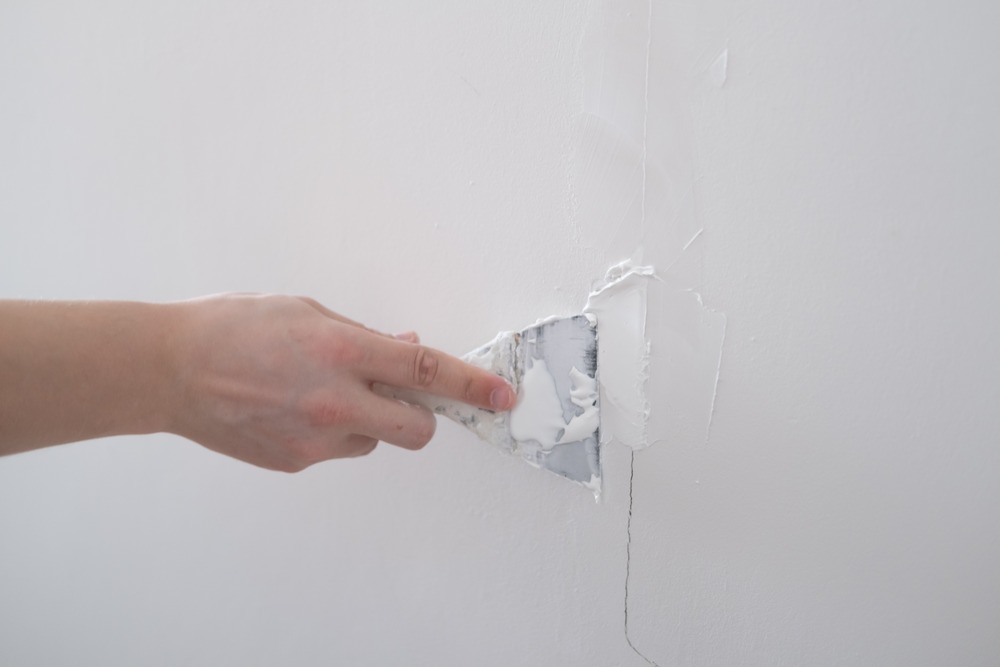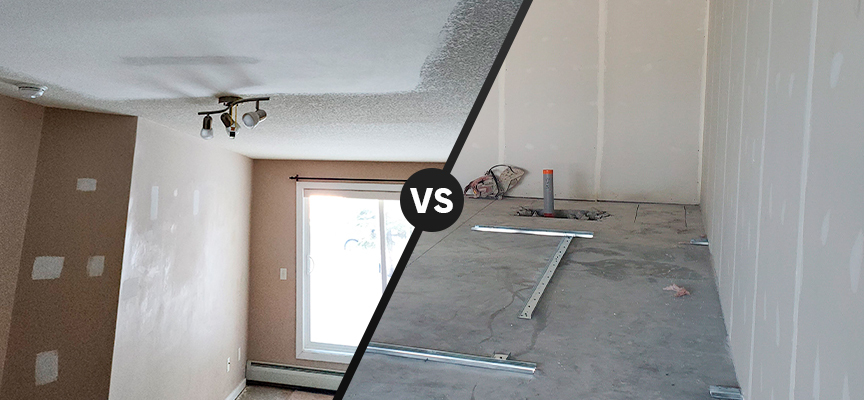Enhance your interiors using Drywall Repair Ogden UT and customized painting styles.
Wiki Article
Step-by-Step Approaches to Achieving Flawless Drywall Fixing and Setup
Achieving flawless drywall fixing and installation requires a systematic strategy. It involves recognizing the different kinds of drywall and the devices essential for the job. Appropriate location prep work is crucial prior to starting any kind of job. drywall contractor. Each action, from covering openings to mounting brand-new sheets, needs interest to detail. The procedure doesn't finish with setup; finishing techniques are critical for a refined look. The following steps will ensure a seamless outcome, but just what do they involve?Understanding Drywall Kind and Tools Needed

The installation devices are just as vital. An utility blade is crucial for cutting drywall sheets, while a drywall saw can aid in making accurate cuts for components or outlets. T-squares ensure exact measurements, and drywall screws or nails secure the panels to wall surface studs. In addition, a drywall lift can assist in the setup of large sheets, lessening physical strain. Knowledge with these types and devices significantly adds to the performance and quality of drywall projects.
Preparing the Location for Repair Service or Setup
Preparing the area for drywall repair work or installment is crucial to assure a smooth and effective process. The surrounding room ought to be cleared of furniture and various other obstacles to supply enough working area. This not only assures safety and security however likewise stops damage to possessions. Next, it is vital to cover the floor with decline towels to catch any kind of particles or dust produced during the job.In addition, the wall surfaces should be inspected for any loosened paint or wallpaper that might disrupt attachment. Removing these aspects creates a clean surface for the new drywall. Before start, it is recommended to turn off power to electric outlets or fixtures around. Making sure ample lighting in the workspace will better enhance presence and focus throughout the repair service or installment procedure. drywall contractors. By meticulously preparing the location, one lays the groundwork for an effective drywall job
Step-by-Step Process for Patching Holes

Covering holes in drywall calls for a systematic approach to assure a smooth repair work. The primary step includes evaluating the size of the opening. For tiny holes, a patching substance might be sufficient, while larger holes necessitate a patch. Next off, the broken area should be cleansed and prepared by getting rid of any type of loosened particles.
For little holes, applying spackling compound with a putty knife is advised, smoothing it over the hole and feathering the edges. As soon as dry, sanding the location guarantees a smooth surface. For larger holes, a drywall spot should be reduced to dimension, positioned over the hole, and safeguarded with screws. After mounting the patch, the same spackling process is repeated, followed by fining sand.
The patched area must be topped and painted to match the bordering wall surface. This meticulous procedure ensures a professional look and expands the life-span of the fixing.
Mounting New Drywall Sheets: A Comprehensive Overview
Installing new drywall sheets calls for mindful planning and execution to guarantee a aesthetically enticing and tough surface. First, the area must be measured precisely to identify the number of sheets needed. It is important to choose the ideal density, usually 1/2-inch for indoor wall surfaces and 5/8-inch for ceilings or fire-rated applications.Next off, the studs or framework must be inspected for any type of irregularities, seeing to it they are lined up and properly spaced. When positioning the drywall sheets, they need to be placed flat to decrease joints and boost structural honesty. A drywall lift can be valuable for overhanging setups.
Fastening the sheets with drywall screws at proper intervals makes specific a safe installation. It is essential to countersink the screws somewhat below the surface area to prepare for the finishing process. Following these standards will bring about a strong structure, ready for the following steps in drywall finishing.
Ending Up Touches: Taping, Mudding, and Fining Sand Strategies
As soon check here as the drywall sheets are securely attached, the emphasis shifts to the complements that will provide a refined appearance. This process starts with taping, making use of either paper or fiberglass harmonize tape to cover the seams between sheets. The tape ensures a smooth change, minimizing the threat of fracturing. Complying with taping, mudding is crucial; a joint substance is used over the tape to fill gaps and produce a seamless surface. Usually, several coats are necessary, each one feathery out further than the before decrease presence.After enough drying time, fining sand is the final action in attaining a flawless surface. A fine-grit sandpaper is used to smooth the dried compound, ensuring there are no bumps or blemishes. Attention to detail during this phase is substantial, as it greatly affects the total appearance of the wall. The end outcome need to be an also, professional-looking surface all set for priming and paint.
Frequently Asked Questions
Just how Do I Choose the Right Drywall Thickness for My Task?
To choose the right drywall density, take into consideration the project's purpose, location, and structural demands. Requirement densities consist of 1/2-inch for general use and 5/8-inch for fire-rated applications, ensuring toughness and compliance with structure codes.
Can I Mount Drywall Over Existing Drywall?
Yes, mounting drywall over existing drywall is feasible. It is crucial to assure the underlying surface is secure and complimentary from damage. Correct fastening and consideration of thickness are vital for a successful installment.What Are the most effective Practices for Drywall Disposal?
The very best practices for drywall disposal consist of reusing when feasible, utilizing local waste administration services, and following standards for harmful materials if relevant. drywall contractor. Properly identifying and sealing waste warranties compliance and security throughout disposalFor how long Should I Await Mud to Dry Before Sanding?
Commonly, one should wait 24 hours for drywall mud to completely dry before sanding. Nevertheless, drying time can differ based upon humidity and temperature level, so looking for a firm structure is a good idea prior to proceeding.Exist Eco-Friendly Drywall Options Available?
Yes, eco-friendly drywall options are available. These alternatives typically utilize recycled products, low-VOC adhesives, and sustainable manufacturing approaches, decreasing ecological effect while giving effective insulation and toughness for various construction and improvement projects.An utility blade is essential for cutting drywall sheets, while a drywall saw can assist in making accurate cuts for electrical outlets or fixtures. Preparing the area for drywall repair work or installation is essential to assure a effective and smooth procedure. Covering holes in drywall calls for a systematic technique to ensure a smooth repair work. Setting up new drywall sheets requires mindful preparation and execution to guarantee a strong and visually enticing coating. Yes, mounting drywall over existing drywall is feasible.
Report this wiki page